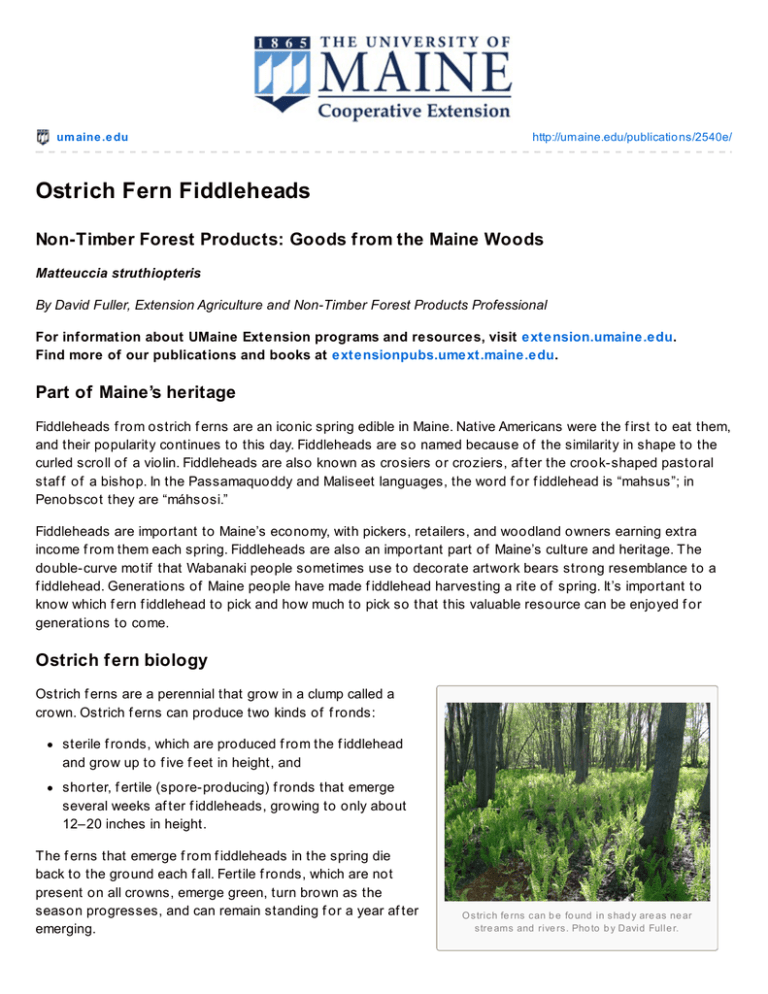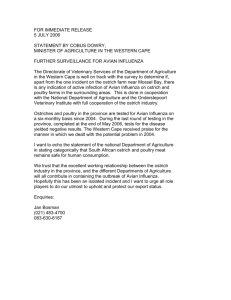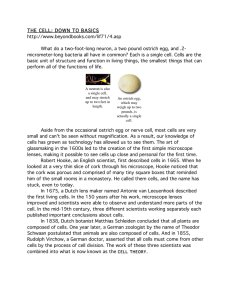Ostrich Fern Fiddleheads Part of Maine’s heritage
advertisement

um aine .e du http://umaine.edu/publicatio ns/2540e/ Ostrich Fern Fiddleheads Non-Timber Forest Products: Goods f rom the Maine Woods Matteuccia struthiopteris By David Fuller, Extension Agriculture and Non-Timber Forest Products Professional For information about UMaine Extension programs and resources, visit extension.umaine.edu. Find more of our publications and books at extensionpubs.umext.maine.edu. Part of Maine’s heritage Fiddleheads f rom ostrich f erns are an iconic spring edible in Maine. Native Americans were the f irst to eat them, and their popularity continues to this day. Fiddleheads are so named because of the similarity in shape to the curled scroll of a violin. Fiddleheads are also known as crosiers or croziers, af ter the crook-shaped pastoral staf f of a bishop. In the Passamaquoddy and Maliseet languages, the word f or f iddlehead is “mahsus”; in Penobscot they are “máhsosi.” Fiddleheads are important to Maine’s economy, with pickers, retailers, and woodland owners earning extra income f rom them each spring. Fiddleheads are also an important part of Maine’s culture and heritage. T he double-curve motif that Wabanaki people sometimes use to decorate artwork bears strong resemblance to a f iddlehead. Generations of Maine people have made f iddlehead harvesting a rite of spring. It’s important to know which f ern f iddlehead to pick and how much to pick so that this valuable resource can be enjoyed f or generations to come. Ostrich f ern biology Ostrich f erns are a perennial that grow in a clump called a crown. Ostrich f erns can produce two kinds of f ronds: sterile f ronds, which are produced f rom the f iddlehead and grow up to f ive f eet in height, and shorter, f ertile (spore-producing) f ronds that emerge several weeks af ter f iddleheads, growing to only about 12–20 inches in height. T he f erns that emerge f rom f iddleheads in the spring die back to the ground each f all. Fertile f ronds, which are not present on all crowns, emerge green, turn brown as the season progresses, and can remain standing f or a year af ter emerging. O s tric h fe rns c an b e fo und in s had y are as ne ar s tre ams and rive rs . Pho to b y David Fulle r. Fiddleheads can be established by spores, but grow more quickly f rom underground stems called rhizomes. In a f avorable site, ostrich f erns can spread to cover acres of ground. Ostrich f erns grow primarily along stream and river f loodplains in part shade, under the canopy of trees such as red and silver maples and brown ash. Ostrich f ern identif ication It is important to properly identif y ostrich f erns. Bracken f erns, f or example, have been shown to cause cancer in rats under laboratory conditions 1, and can cause other problems in livestock. Not enough is known about other f erns to recommend eating them. T here are three ways to identif y ostrich f ern f iddleheads in the spring: 1. T here is a deep, ”U”-shaped groove on the inside of the smooth stem. 2. T here are thin, brown, paper-like scales covering the newly emerging f iddleheads. T he scales f all of f as the f iddlehead grows and elongates. 3. T he f ertile, spore-bearing f rond is distinctive in shape, and also has a groove on the inside of the stem. When present during harvest time, the previous year’s f ertile f rond will be dark brown in color. Not all ostrich f ern crowns will have f ertile f ronds. In contrast, bracken f ern f iddleheads are f uzzy, and lack the brown paper-like covering and U-shaped groove on the inside of the stem. Later in the season, f ully grown ostrich f erns have other identif ying f eatures. With the help of a f ield guide, you can then identif y ostrich f erns f or a f uture harvest. Identifying Ostrich Fern Fiddleheads Click on the images to view enlargements. Look f or a deep, “U”-shaped groove on the inside of the f iddlehead stem, as well as brown, papery scales covering newly emerging f iddleheads. Photo by David Fuller. T he previous year’s dark brown, spore-bearing f ronds will have a distinctive shape resembling a f eather and a groove on the inside of each stem. Photo by David Fuller. The f iddlehead season Fiddleheads emerge in the spring, starting in late April in southern Maine, and appearing in mid to late May in f ar northern Maine. T hey grow rapidly, up to several inches a day under optimum conditions, so the season in a given location is quite short. Sustainable harvest guidelines Bef ore harvesting f iddleheads, make sure that you have the permission of the landowner. If you are not sure who owns the property, check with the town of f ice where the property is located to get the owner’s name. Consider of f ering to pay the landowner an agreed-upon price per pound f or the f iddleheads you pick, or some cleaned f iddleheads in exchange f or the privilege of picking. Picking without owner permission has led to land being closed to the harvesting of f iddleheads. Compensating the owner, on the other hand, helps to reinf orce the value of the f iddlehead resource, and acknowledges the property taxes paid by the landowner. Fiddleheads are harvested in the spring as they emerge f rom the f ern crown. T hey are best harvested at about two to six inches tall, when a portion of the tasty stem can be harvested, but while the f iddlehead is still tightly curled. Fiddleheads should only be harvested f rom healthy crowns that can sustain picking. Such crowns will have at least f our f iddleheads, rather than one or two. T he presence of only one or two f iddleheads in a crown indicates low f ern vigor or a newly established f ern. Harvest f iddleheads by snapping them of f by hand or cutting them of f with a knif e. When cutting f iddleheads, take care not to damage the remaining f iddleheads. T he f iddleheads that remain to grow into f ern f ronds will be making f ood f or the next year’s picking. Research conducted by the University of Maine suggests that picking all of the emerged f iddleheads on a crown every year over a series of years results in the decline and of ten death of the f ern. T he f our-year harvest study compared the ef f ects of harvesting f iddleheads f rom three groups of ostrich f erns. One group had all of the emerged f iddleheads in each crown removed, the second group had one-half of the emerged f iddleheads removed, and the control group had no f iddleheads removed. T he control group and the half -harvested f erns were able to keep producing nearly the same amounts of f iddleheads in subsequent years, while the all-harvested crowns produced very f ew or no f iddleheads af ter f our years. Picking no more than one half of the emerged f iddleheads f rom each crown, with no f ollow-up harvest of lateremerging f iddleheads in the same season, appears to be sustainable. Saf e f iddlehead handling tips When picking f iddleheads, make sure to harvest them into clean containers. Use potable water when cleaning the f iddleheads, not water f rom streams or rivers. Ref rigerate your harvest as soon as possible to maintain f reshness. For more inf ormation on cooking f iddleheads, please ref er to UMaine Extension’s f act sheet, Facts on Fiddleheads. Market considerations Fresh f iddleheads can be marketed in many ways, including f armers markets, restaurants, roadside stands, supermarkets, and shipping by mail. Better prices can be charged f or f iddleheads that have been cleaned to remove their papery coverings. Consider including cooking directions when marketing directly to the consumer. T he papery covering on f iddleheads is most easily removed when dry. Small amounts of f iddleheads can be cleaned by rubbing the covering loose. Larger amounts can be rubbed, then winnowed in f ront of a f an outdoors, which helps blow the papery covering of f . The Centers for Disease Control (CDC) has investigated a number of outbreaks of food-borne illness associated with fiddleheads. The implicated ferns were eaten either raw or lightly cooked (sautéed, parboiled, or microwaved), which was what caused a food-borne illness outbreak in British Columbia in 1990. Although a toxin has not been identified in the fiddleheads of the ostrich fern, the findings of this investigation suggest that you should cook fiddleheads thoroughly before eating (boil them for at least 15 minutes). 1 P.M. Newberne, “Biologic Ef f ects of Plant Toxins and Af latoxins in Rats,” Journal of the National Cancer Institute 56, no. 3 (1976): 551–5. Reviewed by Dave Wilsey, Assistant Extension Professor, University of Minnesota Extension; and Julie A. Miedtke, Extension Educator, University of Minnesota Extension Information in this publication is provided purely for educational purposes. No responsibility is assumed for any problems associated with the use of products or services mentioned. No endorsement of products or companies is intended, nor is criticism of unnamed products or companies implied. © 2012 Published and distributed in f urtherance of Cooperative Extension work, Acts of Congress of May 8 and June 30, 1914, by the University of Maine and the U.S. Department of Agriculture cooperating. Cooperative Extension and other agencies of the USDA provide equal opportunities in programs and employment. Call 800-287-0274 or T DD 800-287-8957 (in Maine), or 207-581-3188, for information on publications and program offerings from University of Maine Cooperative Extension, or visit extension.umaine.edu. The University of Maine does not discriminate on the grounds of race, color, religion, sex, sexual orientation, including transgender status and gender expression, national origin, citizenship status, age, disability, genetic information or veteran’s status in employment, education, and all other programs and activities. The following person has been designated to handle inquiries regarding non-discrimination policies: Director, Office of Equal Opportunity, 101 North Stevens Hall, 581-1226.








